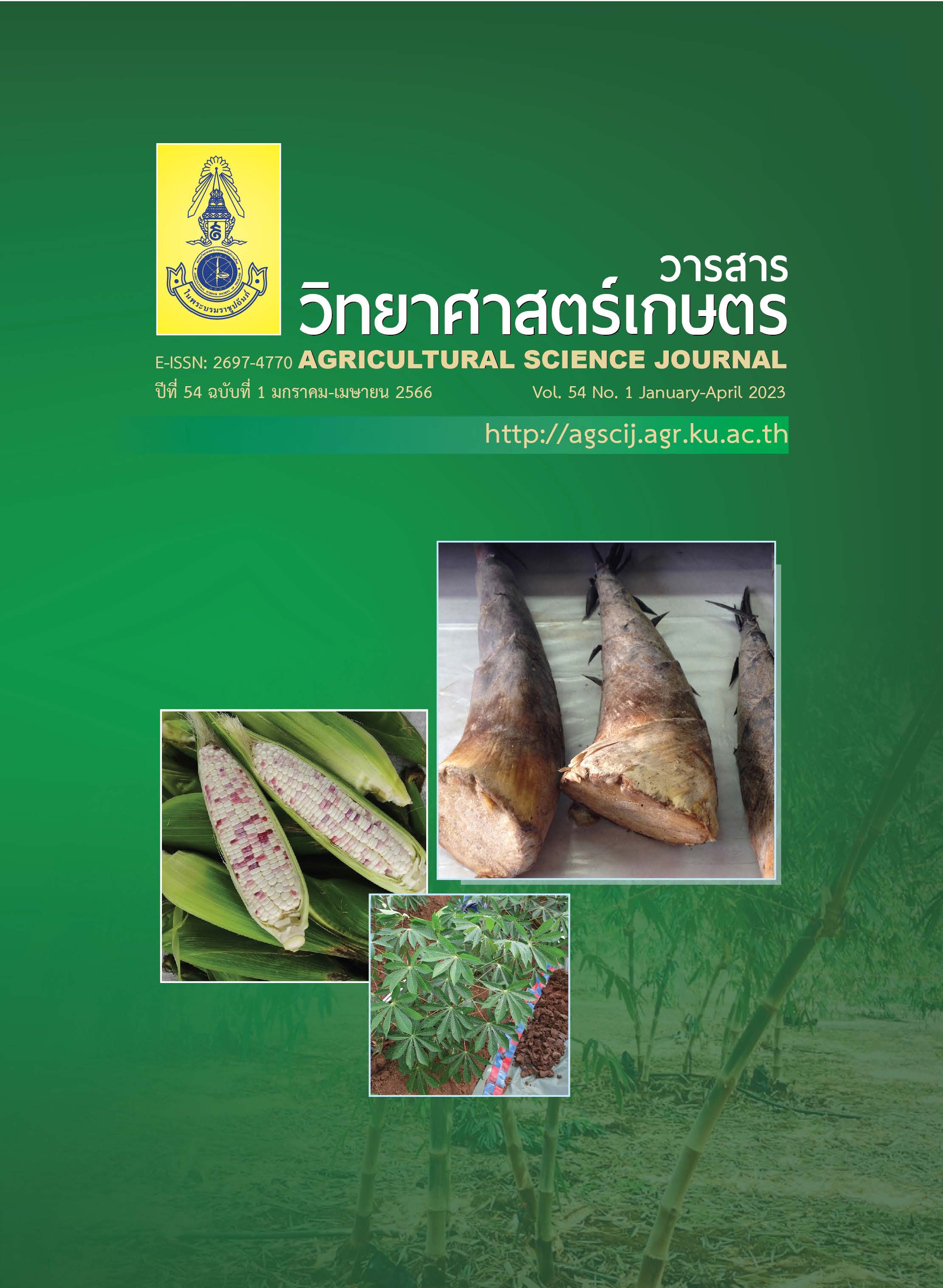การจัดกลุ่มและการวิเคราะห์องค์ประกอบหลักทางด้านลักษณะเหนียวนุ่มของข้าวโพดข้าวเหนียวด้วยการวิเคราะห์ข้อมูลหลายตัวแปร
Main Article Content
บทคัดย่อ
ข้าวโพดข้าวเหนียวมีลักษณะคุณภาพการบริโภคที่มีความจำเพาะโดยมีเนื้อสัมผัสเหนียวนุ่มใช้ในการจำแนกชนิดข้าวโพดข้าวเหนียวที่ต่างกันซึ่งจำเป็นต้องอาศัยข้อมูลหลายตัวแปร (Multivariant) งานวิจัยนี้มีวัตถุประสงค์เพื่อจัดกลุ่มและวิเคราะห์องค์ประกอบสำคัญของพันธุ์ข้าวโพดข้าวเหนียว 30 พันธุ์/สายพันธุ์/ลูกผสม ด้วยวิธีการวิเคราะห์ข้อมูลหลายตัวแปร ได้แก่ สมบัติทางเคมี สมบัติทางด้านความหนืด และการทำงานของเอนไซม์ไอโซอะไมเลส การวิเคราะห์องค์ประกอบหลัก พบว่าแบ่งได้เป็น 2 องค์ประกอบหลักครอบคลุมความแปรปรวนของตัวแปรทั้งหมดได้ร้อยละ 68.8 ประกอบด้วย องค์ประกอบที่ 1 เป็นองค์ประกอบของการเกิดเจลาติไนเซชัน องค์ประกอบที่ 2 เป็นองค์ประกอบของการเกิดเรโทรเกรเดชันหรือการคืนตัวของแป้ง เมื่อนำทั้งสององค์ประกอบมาจัดกลุ่มด้วย K-means clustering พบว่า ข้าวโพดข้าวเหนียวสายพันธุ์แท้ ได้แก่ PWHB01 และ WTNGB003 ข้าวโพดข้าวเหนียวลูกผสม ได้แก่ CNW1602 และ CNW1627 มีค่ากลางหรือค่าเฉลี่ยของหลายตัวแปรใกล้เคียงกับข้าวโพดข้าวเหนียวลูกผสมพันธุ์การค้า การจัดกลุ่มสามารถจัดได้ 2 กลุ่ม ดังนี้ กลุ่มที่ 1 ประกอบด้วย ข้าวโพดข้าวเหนียวจำนวน 13 พันธุ์/สายพันธุ์/ลูกผสม ข้าวโพดข้าวเหนียวในกลุ่มนี้มีความสัมพันธ์กับองค์ประกอบการเกิดเจลาติไนเซชัน กลุ่มที่ 2 ประกอบด้วย ข้าวโพดข้าวเหนียวจำนวน 17 พันธุ์/สายพันธุ์/ลูกผสม ข้าวโพดข้าวเหนียวในกลุ่มนี้มีความสัมพันธ์กับองค์ประกอบการเกิดเรโทรเกรเดชัน พบว่าข้าวโพดข้าวเหนียวสายพันธุ์แท้ PWHB01 และ WTNGB003 ข้าวโพดข้าวเหนียวลูกผสม CNW1602 และ CNW1627 มีค่าความหนืดสูงสุดและการแตกตัวของแป้งสูง แต่มีค่าการคืนตัวต่ำ เนื้อสัมผัสของฟลาวร์จะมีลักษณะเหนียวนุ่มใกล้เคียงพันธุ์เปรียบเทียบ ข้อมูลของหลายตัวแปรในงานวิจัยนี้เป็นข้อมูลพื้นฐานที่สำคัญ ซึ่งนำมาใช้คัดเลือกข้าวโพดข้าวเหนียวให้ได้พันธุ์ที่มีลักษณะเหนียวนุ่มและลักษณะคุณภาพการบริโภคที่ดีเป็นที่ยอมรับของผู้บริโภคต่อไป
Article Details

อนุญาตภายใต้เงื่อนไข Creative Commons Attribution-NonCommercial-NoDerivatives 4.0 International License.
เอกสารอ้างอิง
American Association of Cereal Chemists. 2000. Approve Methods of the American Association of Cereal Chemists. 10th edition. The American Association of Cereal Chemists, Minnesota, USA.
Azanza, F., B.P. Klein and J.A. Juvik. 1996. Sensory characterization of sweet corn lines differing in physical and chemical composition. J. Food Sci. 61(1): 253–257.
Boonlertnirun, K. and C. Jompuk. 2013. Waxy corn hybrid classification by multivariate analysis. RMUTSB Acad. J. 1(1): 41–50. (in Thai)
Hung, P.V., T. Maeda and N. Morita. 2007. Study on physicochemical characteristics of waxy and high amylose wheat starches in comparison with normal wheat starch. Starch 59(3–4): 125–131.
Inpik, N. and B. Kongsamai. 2019. Genetic diversity of some morphological characteristic of Amorphophallus muelleri Blume using multivariate analysis. JSTKU 8(2): 21–31. (in Thai)
Jane, J., Y.Y. Chen, L.F. Lee, A.E. McPherson, K.S. Wong, M. Radosavljevic and T. Kasemsuwan. 1999. Effects of amylopectin branch length and amylose content on the gelatinization and pasting properties of starch. Cereal Chem. 76(5): 629–637.
Ketthaisong, D., B. Suriharn, R. Tangwongchai, J.L. Jane and K. Lertrat. 2015. Physicochemical and morphological properties of starch from fresh waxy corn kernels. J. Food Sci. Technol. 52(10): 6529–6537.
Kim, W.S. and P.A. Seib. 1993. Apparent restriction of starch swelling in cooked noodles by lipids in some commercial wheat flours. Cereal Chem. 70(4): 367–372.
Li, L., H. Jiang, M. Campbell, M. Blanco and J.L. Jane. 2008. Characterization of maize amyloseextender (ae) mutant starches. Part I: Relationship between resistant starch contents and molecular structures. Carbohydr. Polym. 74(3): 396–404.
Liaotrakoon, W. and V. Liaotrakoon. 2020. Effect of acid modification and pre-gelatinization methods on physicochemical properties of water chestnut flour. JFTSU 15(2): 82–95. (in Thai)
Pérez, S. and E. Bertoft. 2010. The molecular structure of starch component and their contribution to the architecture of starch granules. Starch. 62: 389–420.
Phapumma, A., T. Monkham, J. Sanitchon and S. Chankaew. 2020. Evaluation of amylose content, textural properties and cooking qualities of selected glutinous rice. Khon Kaen Agr. J. 48(3): 597–606. (in Thai)
R Core Team. 2022. R: A Language and Environment for Statistical Computing. R Foundation for Statistical Computing, Vienna, Austria.
Shittu, T.A., L.O. Sanni, S.O. Awonorin, B. Maziya-Dixon and A. Dixon. 2007. Use of multivariate techniques in studying the flour making properties of some CMD resistant cassava clones. Food Chem. 101(4): 1606–1615.
Simla, S. 2009. Eating Quality Investigation and Improvement in Waxy Corn. PhD Thesis, Khon Kaen University, Khon Kaen.
Simla, S. 2013. Eating quality in vegetable corns. J. Sci. Technol. MSU. 32(3): 337–342.
Simla, S., K. Lertrat and B. Suriharn. 2010. Carbohydrate characters of six vegetable waxy corn varieties as affected by harvest time and storage duration. Asian J. Plant Sci. 9(8): 463–470.
Singh, R.P. and B.A. Anderson. 2004. The major types of food spoilage: an overview, pp. 3–23. In R. Steele, ed. Understanding and Measuring the Shelf-life of Food. Woodhead Publishing, Cambridge, UK.
Syahariza, Z.A., S. Sar, J. Hasjim, M.J. Tizzotti and R.G. Gilbert. 2013. The importance of amylose and amylopectin fine structures for starch digestibility in cooked rice grains. Food Chem. 136(2): 742–749.
Valach, A., G. Moore and E.B. Perry. 2020. Impacts of dietary profile on starch content and gelatinization in canine diets. J. Anim. Sci. 98(Suppl. 4): 56.
Vanichbuncha, K. 2008. Statistics Analysis: Statistics for Management and Research. Department of Statistics, Faculty of Commerce and Accountancy, Chulalongkorn University, Bangkok, Thailand. 589 pp. (in Thai)
Zhu, L., C. Jones, Q. Guo, L. Lewis, C.R. Stark and S. Alavi. 2016. An evaluation of total starch and starch gelatinization methodologies in pelleted animal feed. J. Anim. Sci. 94(4): 1501–1507.


